“Something,” penned by the legendary George Harrison, stands as a testament to his songwriting genius within The Beatles. Released on the iconic “Abbey Road” album, this ballad is celebrated for its captivating chord progression, memorable melody, and soulful guitar solo. Its enduring appeal is evident in being covered by over 150 artists, making it the second most covered Beatles song. Rumored to be inspired by Patti Boyd, Harrison’s former wife, “Something” is a musical gem worthy of deep exploration for any guitarist.
In this lesson, we’ll dissect the guitar chords of “Something”, offering chord diagrams to guide your fingers, and delve into the music theory that underpins its sophisticated chord progression. We will also explore the iconic guitar solo, providing insights into its construction and theoretical basis.
“Something” Guitar Chords
Typically, guitar lessons begin with chord diagrams. However, given the intricate nature of “Something,” let’s first get an overview of the entire chord chart. This will provide context as we break down each section step-by-step.
 Full chord chart for "Something" by The Beatles
Full chord chart for "Something" by The Beatles
With a general map of the chord sequence in mind, let’s now focus on the intro chords for “Something”. The voicings presented below are designed for ease of play, minimizing finger movement between chords.
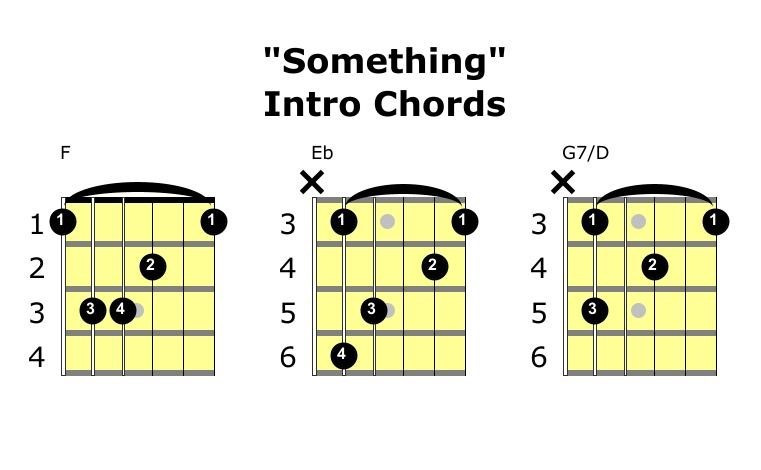 Intro guitar chord diagrams for "Something" by The Beatles
Intro guitar chord diagrams for "Something" by The Beatles
Moving into the verse chords of “Something,” open position voicings shine. They not only offer a rich sound but also represent the most straightforward way to finger these chords on the guitar neck.
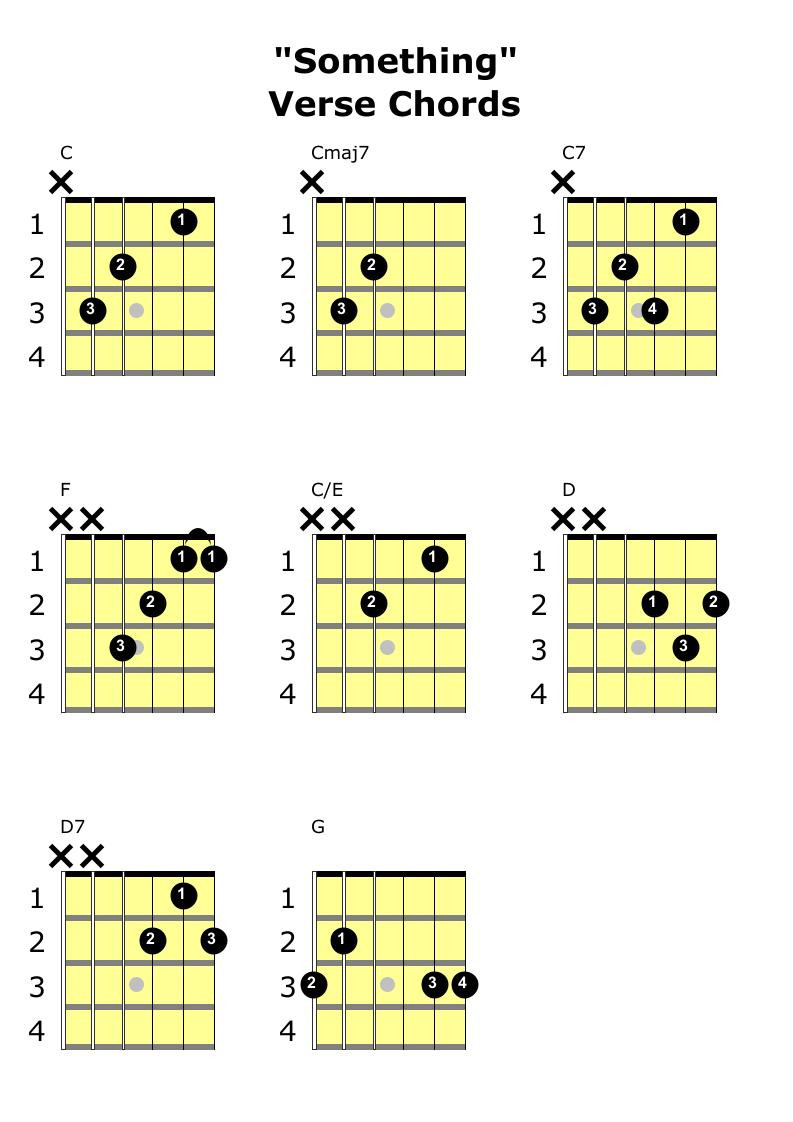 Verse guitar chord diagrams for "Something" by The Beatles
Verse guitar chord diagrams for "Something" by The Beatles
In bar 8, we encounter an A minor section. Here, you’re presented with two distinct ways to voice each Am chord. First, the open position chords, consistent with the verse, transition to a D9 chord at fret 5.
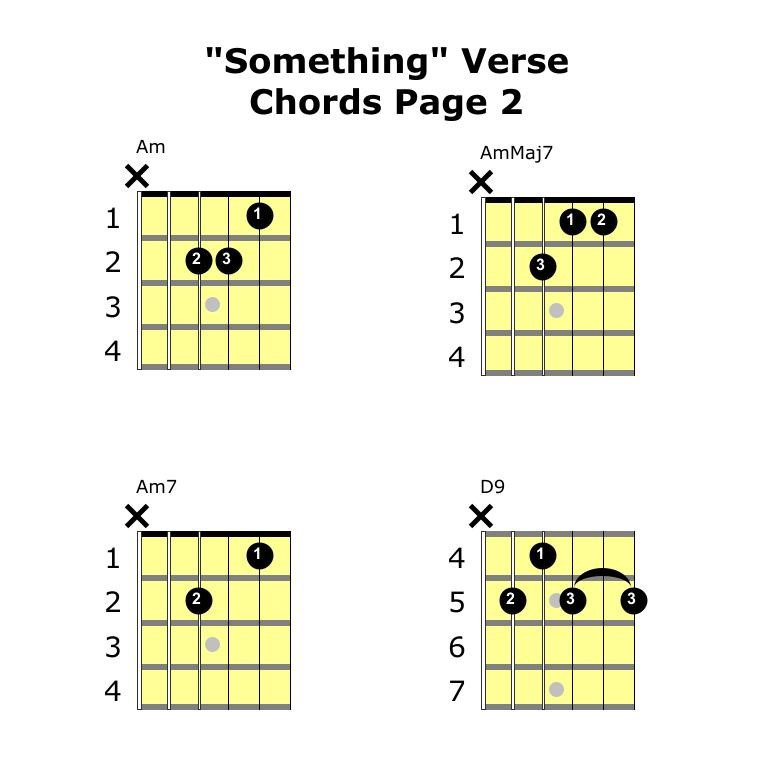 A minor section chords in open position for "Something" by The Beatles
A minor section chords in open position for "Something" by The Beatles
Alternatively, the voicings below offer an option for those comfortable with thumb-fretting. These chords, positioned around the 5th fret, can facilitate a smoother transition to the D9 chord that follows.
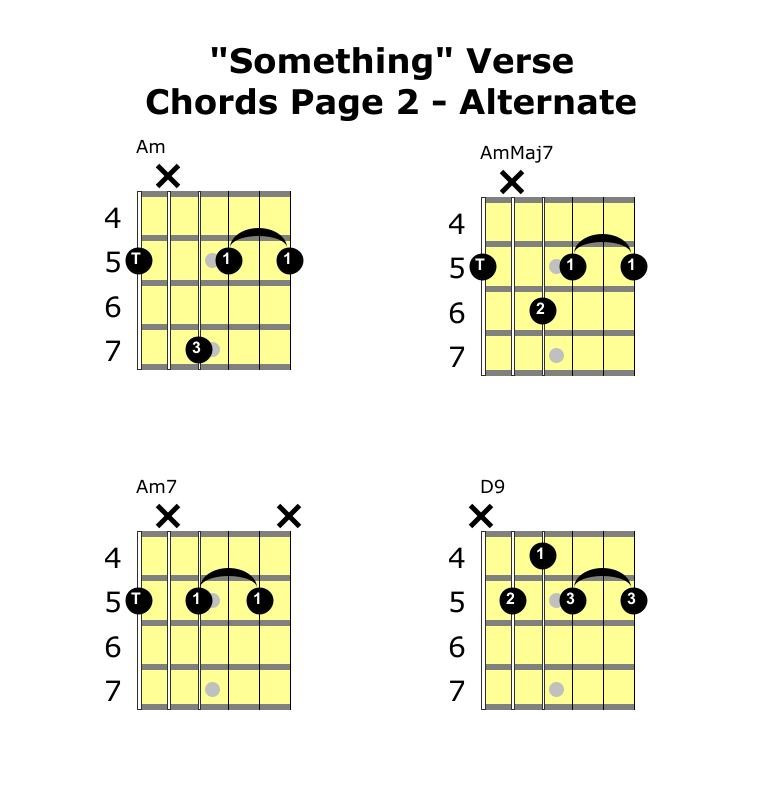 Alternate voicings for A minor section chords for "Something" by The Beatles
Alternate voicings for A minor section chords for "Something" by The Beatles
Finally, let’s explore the chorus chords of “Something”. Voicing the initial four chords on the highest four guitar strings creates a particularly pleasing sound, as reflected in the diagrams below.
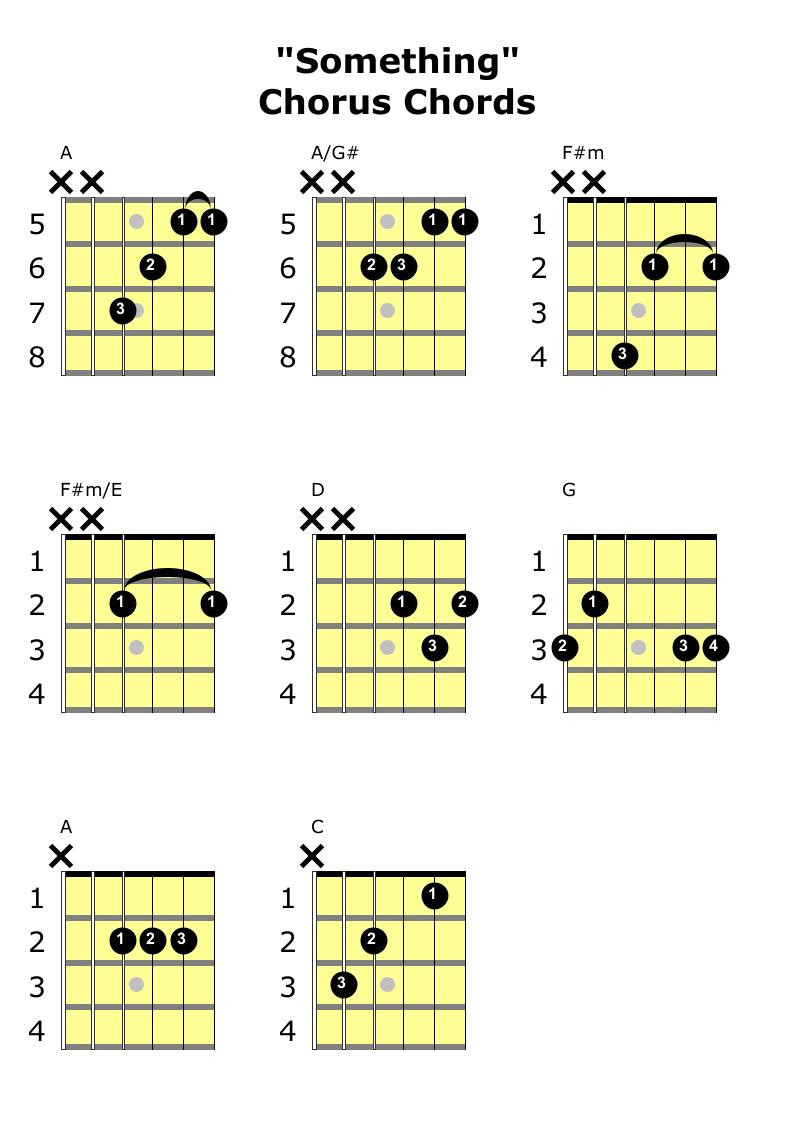 Chorus guitar chord diagrams for "Something" by The Beatles
Chorus guitar chord diagrams for "Something" by The Beatles
For an added layer of authenticity, you might choose to emulate Paul McCartney’s bassline on your guitar instead of strumming the A and C chords at the chorus’s end. Below is the bassline transcribed for guitar over the A chord in bar 15.
Here’s the bassline transposed for guitar over the C chord in bar 19.
 Bassline transcription over A and C chords for "Something" chorus
Bassline transcription over A and C chords for "Something" chorus
“Something” Chord Progression – Music Theory Analysis
Outline
“Something” by The Beatles showcases a remarkably sophisticated chord progression, incorporating advanced music theory concepts that can inspire your own songwriting. While primarily in C Major, the song masterfully utilizes borrowed chords and a captivating modulation in the chorus. For reference, here is the C Major scale harmonized in triads:
| C | D | E | F | G | A | Bdim | C |
|---|---|---|---|---|---|---|---|
| Major | Minor | Minor | Major | Major | Minor | Diminished | Major |
| I | ii | iii | IV | V | vi | vii° | VIII |
And the same scale harmonized in four-note chords for further insight:
| CMaj7 | Dmin7 | Emin7 | FMaj7 | G7 | Amin7 | Bm7b5 | CMaj7 |
|---|---|---|---|---|---|---|---|
| I | ii | iii | IV | V | vi | viiø | VIII |
Intro
The intro of “Something” begins on an F chord, the IV chord in C Major. Immediately, it moves to an Eb chord, borrowed from the parallel minor key of C Minor. This unexpected chord adds a touch of harmonic color right from the start. Finally, a G7 chord with a D in the bass resolves the intro. The G7 acts as the V chord, creating a perfect cadence leading into the C chord at the verse’s start. The descending bassline, moving through F, Eb, D, and finally to C, feels natural and is a key element in the chord choices, creating a smooth and engaging harmonic movement.
Verse
The verse of “Something” opens on the I chord, C, presented in three variations: C, Cmaj7, and C7. This sequence is a prime example of “chromatic embellishment of static harmony.” In simpler terms, the foundational C chord remains constant, while a single note within the chord shifts each bar, creating new chord qualities. The core C major triad (C, E, & G) is maintained throughout. In the first C Major chord, the octave C descends a semitone to B, forming Cmaj7 (C, E, G, & B). Then, B descends another semitone to Bb, resulting in C7 (C, E, G, & Bb). This technique, also heard in Stevie Wonder’s “I Just Called To Say I Love You” and Sixpence None The Richer’s “Kiss Me,” adds subtle yet rich harmonic variation.
As indicated in the chord chart, C7 is not diatonic to C Major, making it another borrowed chord. Specifically, it functions as the dominant chord of F in bar 4, setting up a perfect cadence to the F chord (IV in C Major). The progression then returns to chord I with C/E. Here, the 3rd of C, E, is placed in the bass, crafting a descending bassline from F to E and then to D in bar 5.
Bar 5 features both D and D7 chords, neither of which are diatonic to C Major. These chords effectively create another V-I cadence, this time resolving to the G chord in bar 6. D is the V chord in G Major, creating a temporary shift in tonal focus. Next, in bar 8, we encounter A minor, the relative minor of C. Here, we see another instance of chromatic embellishment, with three A minor variations across bars 8 and 9. The A minor triad (A, C, E) is embellished by chromatically descending the octave A. It descends a semitone to G#, creating AmMaj7 (A, C, E, G#), borrowed from the A harmonic minor scale. G# then descends to G, forming Am7 (A, C, E, G). This chord progression is prevalent in jazz standards like “My Funny Valentine,” Led Zeppelin’s “Stairway To Heaven,” and the James Bond Theme. The G in Am7 then descends to F#, while the root shifts to D, yielding the D9 chord in bar 9 (D, F#, A, C, E).
Chorus
The chorus of “Something” introduces a beautiful modulation to A Major. Here’s the A Major scale harmonized in triads:
| A | Bm | C#m | D | E | F#m | G#dim | A |
|---|---|---|---|---|---|---|---|
| Major | Minor | Minor | Major | Major | Minor | Diminished | Major |
| I | ii | iii | IV | V | vi | vii° | VIII |
A Major, being the relative major of C# minor (and parallel major of A minor which is relative minor of C Major), creates a naturally pleasing and uplifting shift. The chorus begins on chord I of A Major, before moving to the same chord with a G# in the bass, creating an Amaj7 sound (A, C#, E, & G#). This bass note creates a smooth, descending bassline from A to G# to the F#m chord (vi in A Major), ultimately leading to F#m/E. A temporary key change occurs a whole tone lower to G Major, with chords I (G) and V (D), before modulating back to A Major. On the repeat, instead of returning to A, the progression cleverly modulates back to the original key of C Major.
Guitar Intro Tab For “Something”
George Harrison’s guitar work on “Something” is nothing short of immaculate. In this section, we provide the guitar tab for the intro lick, as well as the complete tab for the iconic guitar solo that follows the chorus. We’ll also analyze Harrison’s note choices and their relationship to the underlying chords. Let’s begin with the intro lick:
A key element of the intro’s brilliance is Harrison’s use of chord tones. He starts by playing the 3rd of F (A), then bends up to the 5th (C). Over the Eb chord, he emphasizes the 5th (Bb) before moving up a semitone to B, which becomes the 3rd of Eb. He concludes the chromatic movement with the root note of C. Masterful melodic phrasing!
“Something” – Guitar Solo Tab
Below is a transcription of George Harrison’s unforgettable guitar solo from “Something.”
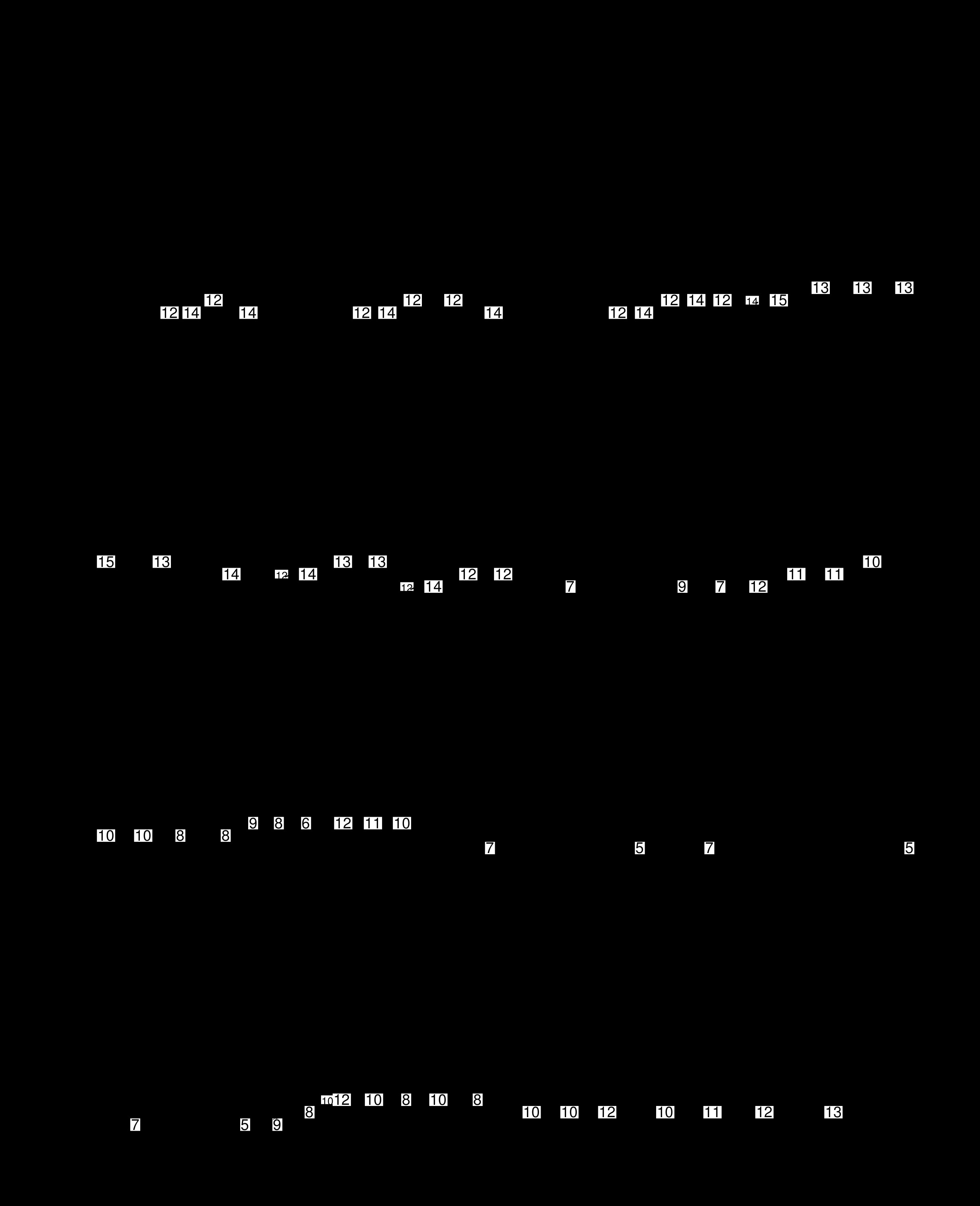 Guitar solo tab for "Something" by George Harrison of The Beatles
Guitar solo tab for "Something" by George Harrison of The Beatles
Guitar Solo – Theory Analysis
As previously mentioned, Harrison’s genius in this solo lies in his consistent use of chord tones, strategically landing on key notes at precisely the right moments. The table below outlines the notes within each chord of the verse progression, over which Harrison improvises his solo:
| Chord | Notes (Root, Intervals) |
|---|---|
| C | C E G (Root, 3rd, 5th) |
| CMaj7 | C E G B (Root, 3rd, 5th, 7th) |
| C7 | C E G Bb (Root, 3rd, 5th, b7th) |
| F | F A C |
| C/E | E G C (3rd, 5th, Root) |
| D | D F# A (Root, 3rd, 5th) |
| D7 | D F# A C (Root, 3rd, 5th, b7th) |
| G | G B D (Root, 3rd, 5th) |
| Am | A C E (Root, b3rd, 5th) |
| AmMaj7 | A C E G# (Root, b3rd, 5th, Maj7) |
| Am7 | A C E G (Root, b3rd, 5th, b7th) |
| D9 | D F# A C E (Root, 3rd, 5th, b7th, 9th) |
The following tab of Harrison’s solo is annotated with the intervals of each note relative to the underlying chord, providing a clear view of his note choices and targets.
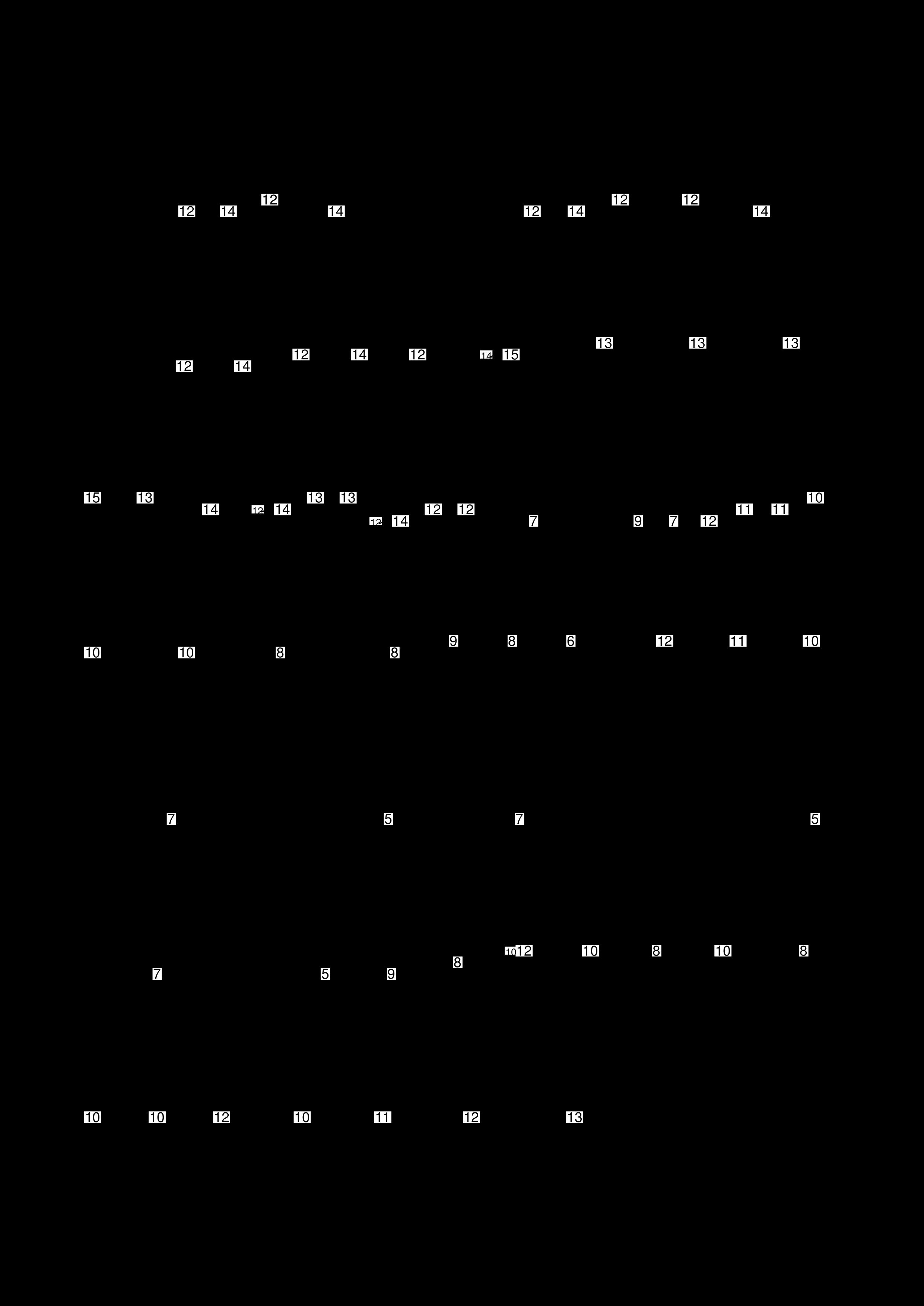 Guitar solo theory analysis tab for "Something" by George Harrison
Guitar solo theory analysis tab for "Something" by George Harrison
As the analysis reveals, Harrison consistently targets chord tones throughout his solo, with a particular emphasis on 3rds and 5ths. These are strong choices, as landing on the root can sometimes sound too predictable. To apply this to your own playing, identify the chords in a progression, determine their constituent notes, and aim to resolve your phrases on the 3rd or 5th of the chord. Notably, the “outside” notes Harrison plays over the G chord in bar 6 are particularly interesting. This phrase, incorporating altered notes like b5s and b13s, evokes the style of jazz guitarists, possibly inspired by Django Reinhardt, an acknowledged early influence on Harrison. This lick seems designed to build tension before the bending lick in bar 7. Despite its unconventional note choices, it remains remarkably melodic and effective.
Final Thoughts
I trust you’ve enjoyed this exploration of “Something” by The Beatles, encompassing both guitar chords and music theory. “Something” is a rewarding song to learn, offering both a unique chord progression and a beautifully melodic guitar solo. Hopefully, the analysis has provided you with concepts you can incorporate into your own songwriting and improvisational guitar playing. The Beatles’ musical legacy is vast and influential, and I look forward to analyzing more of their iconic songs in future lessons.
Until next time,
PB.

